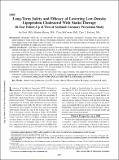Files in this item
Long-term safety and efficacy of lowering low-density lipoprotein cholesterol with statin therapy : 20-year follow-up of West of Scotland Coronary Prevention Study
Item metadata
| dc.contributor.author | Ford, Ian | |
| dc.contributor.author | Murray, Heather | |
| dc.contributor.author | McCowan, Colin | |
| dc.contributor.author | Packard, Chris J. | |
| dc.date.accessioned | 2019-01-31T09:30:06Z | |
| dc.date.available | 2019-01-31T09:30:06Z | |
| dc.date.issued | 2016-03-15 | |
| dc.identifier | 257571876 | |
| dc.identifier | 3db55659-c948-47cc-ae6d-8771ec2d484c | |
| dc.identifier | 84957927612 | |
| dc.identifier.citation | Ford , I , Murray , H , McCowan , C & Packard , C J 2016 , ' Long-term safety and efficacy of lowering low-density lipoprotein cholesterol with statin therapy : 20-year follow-up of West of Scotland Coronary Prevention Study ' , Circulation Research , vol. 133 , no. 11 , pp. 1073-1080 . https://doi.org/10.1161/CIRCULATIONAHA.115.019014 | en |
| dc.identifier.issn | 0009-7330 | |
| dc.identifier.other | ORCID: /0000-0002-9466-833X/work/59465017 | |
| dc.identifier.uri | https://hdl.handle.net/10023/16974 | |
| dc.description | The study was supported by a grant from Merck, Sharp & Dohme, Kenilworth, NJ, as part of an Investigator Initiated Program. | en |
| dc.description.abstract | BACKGROUND Extended follow-up of statin-based low-density lipoprotein cholesterol lowering trials improves the understanding of statin safety and efficacy. Examining cumulative cardiovascular events (total burden of disease) gives a better appreciation of the clinical value of statins. This article evaluates the long-term impact of therapy on mortality and cumulative morbidity in a high-risk cohort of men. METHODS AND RESULTS The West of Scotland Coronary Prevention Study was a primary prevention trial in 45- to 64-year-old men with high low-density lipoprotein cholesterol. A total of 6595 men were randomized to receive pravastatin 40 mg once daily or placebo for an average of 4.9 years. Subsequent linkage to electronic health records permitted analysis of major incident events over 20 years. Post trial statin use was recorded for 5 years after the trial but not for the last 10 years. Men allocated to pravastatin had reduced all-cause mortality (hazard ratio, 0.87; 95% confidence interval, 0.80-0.94; P=0.0007), attributable mainly to a 21% decrease in cardiovascular death (hazard ratio, 0.79; 95% confidence interval, 0.69-0.90; P=0.0004). There was no difference in noncardiovascular or cancer death rates between groups. Cumulative hospitalization event rates were lower in the statin-treated arm: by 18% for any coronary event (P=0.002), by 24% for myocardial infarction (P=0.01), and by 35% for heart failure (P=0.002). There were no significant differences between groups in hospitalization for noncardiovascular causes. CONCLUSION Statin treatment for 5 years was associated with a legacy benefit, with improved survival and a substantial reduction in cardiovascular disease outcomes over a 20-year period, supporting the wider adoption of primary prevention strategies. | |
| dc.format.extent | 660419 | |
| dc.language.iso | eng | |
| dc.relation.ispartof | Circulation Research | en |
| dc.subject | Coronary disease | en |
| dc.subject | Heart failure | en |
| dc.subject | Primary prevention | en |
| dc.subject | Safety | en |
| dc.subject | RA0421 Public health. Hygiene. Preventive Medicine | en |
| dc.subject | RM Therapeutics. Pharmacology | en |
| dc.subject | 3rd-NDAS | en |
| dc.subject | BDC | en |
| dc.subject | R2C | en |
| dc.subject | SDG 3 - Good Health and Well-being | en |
| dc.subject.lcc | RA0421 | en |
| dc.subject.lcc | RM | en |
| dc.title | Long-term safety and efficacy of lowering low-density lipoprotein cholesterol with statin therapy : 20-year follow-up of West of Scotland Coronary Prevention Study | en |
| dc.type | Journal article | en |
| dc.contributor.institution | University of St Andrews. School of Medicine | en |
| dc.identifier.doi | 10.1161/CIRCULATIONAHA.115.019014 | |
| dc.description.status | Peer reviewed | en |
This item appears in the following Collection(s)
Items in the St Andrews Research Repository are protected by copyright, with all rights reserved, unless otherwise indicated.

